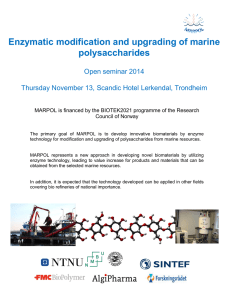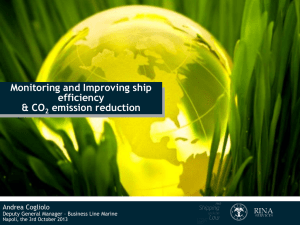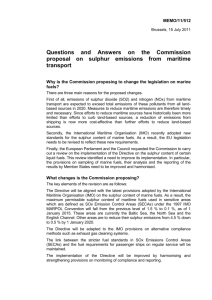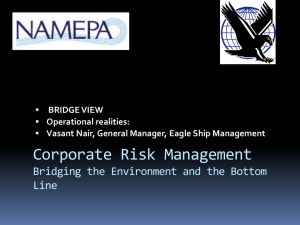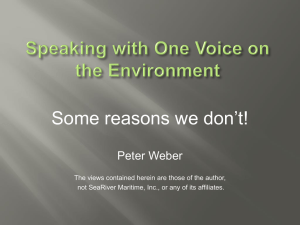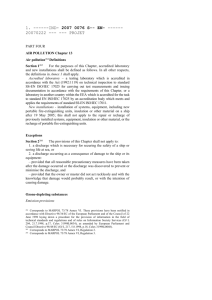Annex 14
advertisement
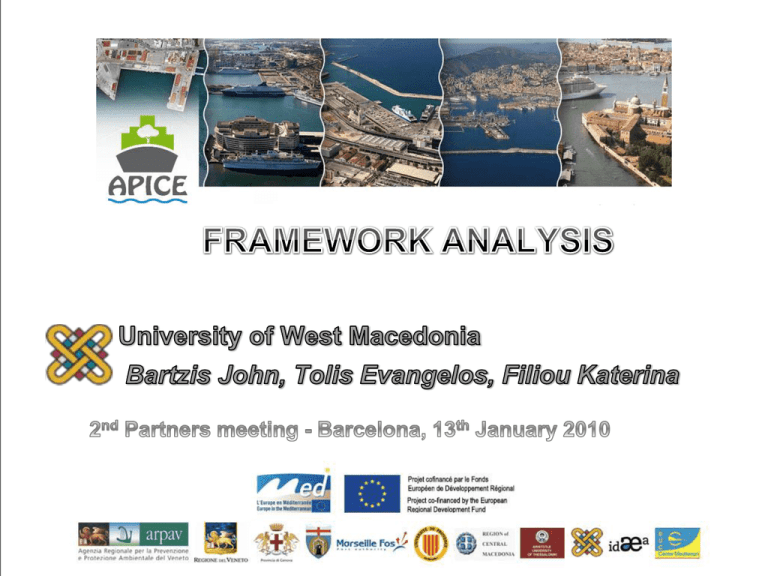
Framework Analysis International European Spain – Barcelona Italy – Genoa , Venice France – Marseille Greece - Thessaloniki 2 International frame 3 ORGANIZATIONS • United Nations Convention on the Law of the Sea (“UNCLOS”) • International Maritime Organization's (“IMO’s”) • Sulphur Oxide Emission Control Areas (“SECAs”) • International Convention on the Prevention of Pollution from Ships (“MARPOL”) 4 United Nations Convention on the Law of the Sea (“UNCLOS”) Gives flag states the primary authority to impose environmental regulations (including those related to air emissions) on marine sources through their responsibility to enforce international laws. Sets out the basic legal framework that governs international shipping. The Convention gives some support for the control of air emissions (Article 212), but this is balanced against the right of ships to innocent passage without being subject to any charges, except for services received. Rely to varying degrees on the monitoring of emissions from ships. 5 International Maritime Organization's (“IMO’s”) Responsible for the oversight of international shipping activity Rely to varying degrees on the monitoring of emissions from ships. 6 Sulphur Oxide Emission Control Areas (“SECAs”) Sets a global limit on fuel sulphur content in the North Sea and the Baltic Sea Rely to varying degrees on the monitoring of emissions from ships 7 International Convention on the Prevention of Pollution from Ships (“MARPOL”) Sets a global limit on fuel sulphur content Sets NOx emissions standards via the IMO “NOx curve” Rely to varying degrees on the monitoring of emissions from ships. 8 MARPOL CONVENTION Marpol 73/78 is the International Convention for the Prevention of Pollution From Ships, 1973 as modified by the Protocol of 1978. ("Marpol" is short for marine pollution and 73/78 short for the years 1973 and 1978.) Designed to minimize pollution of the seas, including dumping, oil and exhaust pollution. OBJECT to preserve the marine environment through the complete elimination of pollution by oil and other harmful substances and the minimization of accidental discharge of such substances. Entered into force on 2 October 1983. As of 31 December 2005, 136 countries, representing 98% of the world's shipping tonnage, are parties to the Convention. All ships flagged under countries that are signatories to MARPOL are subject to its requirements, regardless of where they sail, and member nations are responsible for vessels registered under their respective nationalities. 9 EMISSION CONTROL AREAS (ECA) BY MARPOL Areas (ECA). An Emission Control Area can be designated for SOx and PM, or NOx, or all three types of emissions from ships, subject to a proposal from a Party to Annex VI. Baltic Sea (SOx, adopted: 1997 / entered into force: 2005) North Sea (SOx, 2005/2006) North American ECA, including most of US and Canadian coast (NOx & SOx, 2010/2012) 10 MARPOL NOx EMISSION LIMITS MARPOL SULFUR EMISSION LIMITS European legislation on ambient air quality and emissions 13 Pollutant Concentration Averaging period Legal nature Fine articles (PM2.5) 25 µg/m3 1 year Target value enters into force 1.1.2010 Limit value enters into force 1.1.2015 Sulphur dioxide (SO2) 350 µg/m3 1 hour Limit value enters into force 1.1.2005 24 125 µg/m3 24 hours Limit value enters into force 1.1.2005 3 200 µg/m3 1 hour Limit value enters into force 1.1.2010 18 40 µg/m3 1 year Limit value enters into force 1.1.2010* Lead (Pb) 0.5 µg/m3 1 year Limit value enters into force 1.1.2005 (or 1.1.2010 in the immediate vicinity of specific, notified industrial sources; and a 1.0 µg/m3 limit value applies from 1.1.2005 to 31.12.2009) Carbon monoxide (CO) 10 mg/m3 Maximum daily 8 hour mean Limit value enters into force 1.1.2005 Benzene 5 µg/m3 1 year Limit value enters into force 1.1.2010** Ozone 120 µg/m3 Maximum daily 8 hour mean Target value enters into force 1.1.2010 Arsenic (As) 6 ng/m3 1 year Target value enters into force 1.1.2012 Cadmium (Cd) 5 ng/m3 1 year Target value enters into force 1.1.2012 Nickel (Ni) 20 ng/m3 1 year Target value enters into force 1.1.2012 Polycyclic Aromatic Hydrocarbons 1 ng/m3 1 year Target value enters into force 1.1.2012 Nitrogen dioxide (NO2) Permitted exceedences each year 25 days averaged over 3 years 14 PM10 limits Quality standards for ambient air duration limit tolerance Deadline for compliance with the limit Phase 1 24hour limit for the protection of human health Annual limit value for the protection of human health 24 hours annual 50% the entry into force of this Directive, decreasing 50 μg/m3 which should not from 1/1/2001 and then be exceeded more than 35 every 12 months at an times per calendar year annual rate equal to as much as 0% on 1/1/2005 40 μg/m3 20the entry into force of this Directive, decreasing from 1/1/2001 and then every 12 months at an annual rate equal to as much as 0% on 1/1/2005 1/1/2005 1/1/2005 Phase 2 24hour limit for the protection of human health Annual limit value for the protection of human health 24 hours annual 50 μg/m3 τwhich should not Will be calculated based on be exceeded more than 7 data and is equivalent to times per calendar year the limit of Stage 1 20 μg/m3 50% the entry into force of this Directive, decreasing from 1/1/2001 and then every 12 months at an annual rate equal to as much as 0% on 1/1/2005 1/1/2010 1/1/2010 15 new DIRECTIVE 2008/50/EC Depending on the value of AEI in 2010, a percentage reduction requirement (0,10,15, or 20%) is set in the Directive. If AEI in 2010 is assessed to be over 22 µg/m3, all appropriate measures need to be taken to achieve 18 µg/m3 by 2020. Title Metric Averaging period Legal nature 20 µg/m3 (AEI) Based on 3 year average Legally binding in 2015 (years 2013,2014,2015) Based on 3 year average Reduction to be attained where possible in 2020, determined on the basis of the value of exposure indicator in 2010 PM2.5 Exposure concentration obligation PM2.5 Exposure reduction target Percentage reduction all measures to reach 18 µg/m3 (AEI) Permitted exceedences each year EU MARINE SULPHUR DIRECTIVE 1999/32 Ships in IMO Sulphur Emission Control Areas must use 1.5 percent sulphur fuel or better – starting with the Baltic Sea in May 2006, then extending to the North Sea and Channel in autumn 2007. All passenger vessels on regular services to or from Community ports must use 1.5 percent sulphur fuel or better from May 2006 onward. Ships at berth in ports must use 0.1 percent sulphur fuel or better from 2010 onward. National legislation in Spain 18 Barcelona 19 …Spain Adhesion Instrument to 1997 Protocol to Marpol 73/78 Convention in 2004 Law 34/2007 adopts provisions concerning air quality and environmental protection General Direction of Environmental Quality and Evaluation New royal decree to integrate the new regulations on new pollutants 20 National legislation in France 21 Marseille 22 ...France Regional Plan for Air Quality: PRQA Atmosphere Protection Plan: PPA Urban Transport Plan: PDUr Quality: PRQA ADEME (Agency for the Environment and for Energy Control) (French Approved Association of Air Quality Monitoring: AASQA) 23 National legislation in Italy 24 Genoa 25 Venice 26 …Italy 10 year plan “Polluter Pay” Venice Blue Flag 27 National legislation in Greece 28 Thessaloniki 29 Directive 1996/62/EC on the assessment of the quality of ambient air ΚΥΑ 3277/209 / 02.04.2000 (Gazette 180 Β/00). Determination of general principles and relevant agencies to assess and manage ambient air quality Directive 2000/69/EC relating to limit values for benzene and carbon monoxide in ambient air Directive 2002/3/EC relating to ozone in ambient air ΠΥΣ 34/30-5-2002 (ΦΕΚ 125 A/02). Quality limit values of air pollutants sulfur dioxide, nitrogen dioxide, particulate matter and lead 30
